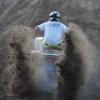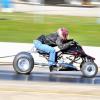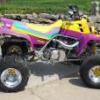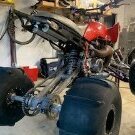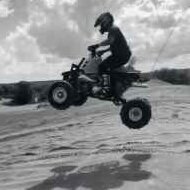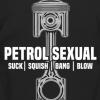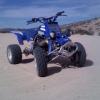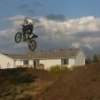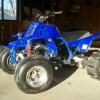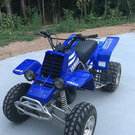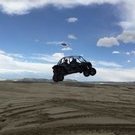Leaderboard
Popular Content
Showing content with the highest reputation since 08/05/2019 in Posts
-
4 points
-
In response to a great question by RagunCajun I thought I'd throw out some trans info including various shifting problems and fixes I've had over the years. His quote "please report back once the pro mod is in. I went from an override to pro mod so I don't know how much better a pro mod is over stock." I'm the odd man out here running airshifted auto 1-4 m5&6 overrides (asphalt) but my son runs 6 speed promods for dirt drags, asphalt and secondary road riding which is legal here in Ohio. My overrides require ignition kill to shift into the non-cut 5th and 6th gears. Without unloading the tranny gear pressure no upshift will happen. My son ran stock trannies for years before upgrading to promods. When it comes to making super-fast "fan the clutch" type shifts his promods are without a doubt easier and far more reliable in making constant shifts over his OEM's but other than that situation I personally don't feel a promod has a great advantage... With regards to the following keep in mind that the troubles we ran into over the years were under race, wide open throttle type conditions/situations: The FIRST thing either of us will do when we run into missed quick shift situations at the track is change the oil. When the oil gets contaminated with clutch material it seems to cause problems with the smooth sliding internals when under pressure. I especially have to watch this in my asphalt Banshee's with multi-stage clutches which slip out of the hole because clutch material sheds off so much faster than usual. *Something I started doing long ago - Because of the contamination I drain the trans at the end of each race day and filter it through a fine paint strainer then let it sit for months to completely settle anything out. When I fill my tranny I use 1 litre of fresh new oil and top off with the strained. As far as transmission mechanical stuff goes: I'd say for sure that one of the most important adjustments to check if you're having problems is the shift/change lever but make certain that all the individual components are good and within spec because it isn't normal for that adjustment to change to the point of causing shifting trouble unless something is broken or heavily worn. A couple of weak links in Banshee transmissions are (1st) OEM second gears can be broke even with small motors. Be there done that in as small as a 358 cub. Robison billets are great imo and I'll leave it at that... (2nd) 3rd wheel gear has a very narrow area that rides on the splined output shaft and once galled shifting nightmares occur. I recommend Molly paste on assembly. A tube will last you forever. Moroso 35000 Moroso Moly Paste Assembly Lubes | Summit Racing Long winded for sure and I don't want to come off as a know it all because I'm still learning with these things. Just hoping that someone might pickup some useful information on my first hand experiences and maybe spark some interest back at the HQ!!4 points
-
If you didn't blow yourself up sucking fuel with a shop vac, you'll be fine mixing different brand oils. Seriously, that is the stupidest thing I've ever heard of.4 points
-
Suspension discussion I’m not really sure that there is a comprehensive guide to ATV suspension anywhere, much less a banshee, so I’ll do my best to throw as much info into this as possible. Terminology (in no particular order): Camber- defines how the tires lean in at the top. The more elevation changes from your left to right (uneven surface or steep berms), the more camber you may want. 1-6* is common. Toe- the inward facing angle of the front tires when viewed from above. More is good for stability in corner exit, straight lines, and rough terrain. Less is good for smooth and slow speed terrain. 2-6* is common. Caster- defines how the top of the steering angle leans back when viewed from the side. Use more caster for rough terrain. Flat track is commonly 1-3*. Desert racing is commonly around 7. Everything else is usually in the middle. Helps keep the tires straight under impacts. More caster will give more camber on the outside tire when turning and can help dig more. Some people add caster to prevent the tire from rolling over the sidewalls on the outside tire, but the real solution isn’t more caster; its to add more tire pressure. Steering Angle Inclination (SAI) or King Pin Inclination (KPI)- the line drawn between the pivot point of the upper and lower ball joints, and how that line is related to the centerline of your tire when viewed from the front. Basically the same as caster except viewed from the front. You can’t change this unless you use different knuckles. When you turn the handlebars, this is the angle your tires turn around when viewed from the front. Google has sufficient info on this. Included angle- the combined angle between KPI and camber. Since you can’t change this with practically any independent front suspension ATV, it is irrelevant here, but it is easy to mix up with KPI. Scrub radius- the distance between the KPI and the center of your contact patch where they meet the ground. This is your #1 contributor to feedback. This is usually 1” or so. You want it at around 1/8”. Different offsets, different tire heights, different tire pressures, camber settings, and different tire profiles affect this. A positive scrub radius means that when you hit something with a front tire, that tire will push back and turn the bars (feedback). A negative scrub radius will make the tire turn the other way. Zero scrub radius can be unpredictable in rough terrain. Flat track setups can vary the most (flat tire profile). 4/1 rims are very good for tires under 21”. 21-23” front tires can be made to work with 3/2 offset, but will come down to rider preference. 95% of all setups will benefit from a 4/1 rim setup. Wheel spacers are neither mechanically not geometrically wise. Scrub- how the tires move in and out through the suspension stroke when viewed from the front. Rake- the angle that the suspension leans back in front. Helps with rough terrain, sudden impacts. Compressed length- the length of the shock when fully compressed. Some give this number when the shock body contacts the bumper, some give it when the bumper is pushed through. Some give both. Too long will cut available up-travel. Too short will cause you to lay the frame on the ground. Extended length- the non-compressed length of the shock. Too long can bind ball joints. Too short cuts ground clearance. Leverage ratio- the ratio of vertical wheel movement to shock shaft movement. Also called a motion ratio. 1.7-2.8 is common. 2-2.4 is most common. 11” of wheel travel and 5.5” of shaft travel equal a 2:1 leverage ratio. Lower ratios are usually better. Long travel- doesn’t necessarily mean more travel. It can be more wheel travel, it can be more shaft travel, it can be both or neither. What it means for the ATV crowd is that the setup in question will have leverage ratios have been altered, usually in favor of a lower ratio. Long travel also means a longer than standard shock is used. Longer shocks are a better choice the majority of the time. Standard travel- uses OEM compressed and extended length shock specs. Preload: how much a spring is compressed beyond its resting length. This is also used when adjusting ride height in that adjusting the retainer down will compress the spring(s) more and increase ride height. Compression- the resistance the valving has to being compressed. Low speed compression- the resistance the valving has to being compressed when compressed slowly. Affects body roll, brake dive, bottom out resistance on the face of a jump or very smooth landing of a jump. High speed compression- the resistance the valving has to being compressed when compressed quickly. Affects impact resistance, choppy terrain, slamming the suspension. NOTE: low or high speed compression has to do with SHOCK movement speed, not ground speed. Rebound- the valving’s resistance to the shock extending too fast. Faster riders and choppy terrain need less rebound. Bump steer- how toe changes through the suspension motion. Feedback- force felt from the terrain that is felt in the handlebars that wants to turn the bars. Feedback and bump steer are NOT the same. PLANNIING A SUSPENSION SETUP This is where most of you fuck up. This assumes you have the money required to build a functional and safe setup. Pick your riding terrain. XC, MX, desert, drag, hillclimb, etc. This will determine tire size, a-arm width, and swingarm length. Choose a-arms based on width required, find companies that offer that length, then take the time to research the company’s background. This is critical for one reason: ball joint limitations. This is a simple concept that isn’t very easy to explain without pictures, so I’ll include this short list: LSR: mostly desert, some MX, some XC. Drag guys, you already know what you’d need from them anyway. Roll Design: mix of desert and MX Fireball: MX, general purpose Alba: desert, General purpose Laeger’s: MX, some desert JB: MX, some XC Fireball: general purpose, dunes Next is swingarm selection. Very simply, shorter is more agile and rider input is easier to see, but they are inherently less stable. It is also much easier to transfer weight front/rear and side to side. Due to a shorter swingarm’s steep angle when at ride height, they can cause the rear of the quad to lift under acceleration. This raises the COG and can cause you to wheelie much more easily. A shorter swingarm will have less travel as well, but will have a lower leverage ratio. Longer is more stable but will reduce turning ability. The major downside beyond handling is weight distribution, but most uses of an excessively long swingarm have no interest in quick cornering. Since they sit at a flatter angle, lifting is far less of an issue. 80% of trail and MX banshees will find the best handling at -1.5 to +2.” This is largely because a banshee is very front heavy and the fenders don’t allow sufficient movement to get enough weight over the back. A -1” swingarm, race position pegs, forward a-arms, lowered subframe, rigid 19” tires, and a wider axle will cut seconds off a lap time. Not tenths. Seconds. XC is very similar out back to MX. Dune guys usually want +2 to +6. No-link setups are best served by relocating the upper shock mount. Otherwise, the leverage ratio will be sky high but it is still doable for some scenarios. Don’t think that the 3-4lbs you save from going no-link will benefit you if you don’t have a good shock built. Solid struts don’t apply here. Choose tire size next. MX setups with front tires ranging from 18-21” can be useful. Rear tires are usually 18-20”. 20/18 is a common setup. I prefer the smallest front tire I can get away with and 18” rears. Bigger tires add comfort and absorb impacts better. Small tires are more nimble and deform less under heavy stress. XC is doable on 20-23” fronts and 19-22” rear. Know your terrain for this. My preference for XC is 21/20. Once you have the frame, arms, link (if used) together and tires INFLATED TO RUNNING PRESSURE, lay the quad down onto 2 2x4s lying flat on the ground. Place one under the frame rails at the pegs and another under the frame rails before they rake up. For MX or TT, use a treated 2x4. For drag, use a treated 2x4 in front and a full size in rear (big tires compress more). For others, use a full size 2x4. Ballpark the alignment. Accuracy isn’t important at THIS step. Just make sure the tires are roughly straight ahead and that the camber isn’t more than 10 degrees. Measure eye to eye where your shocks mount for compressed length front and rear. Accuracy is important here. Check both front lengths to make sure something isn’t bent, broken, etc. Lift the quad up until the instant the tires come off the ground and keep the lower frame rails level. Depending on your components, this may be your front or rear tires. Measure from the 2x4 to the lower frame rails. This is your travel number. Continue lifting until the other tires lose contact and take your second travel measurement. Completely lift the quad off the ground so that the tires hang. Measure eye to eye for both front and rear. This is extended length. Subtract your compressed length from extended length, then divide your travel by this number. Travel/(extended length - compressed length) = leverage ratio. You may end up with something like this: FRONT 14” compressed length 19.5” extended length 11.5” travel 11.5/(19.5-14) = 2.09:1 leverage ratio REAR 9.5” compressed length rear 13.5” extended length rear 10.3” travel rear 10.3/(13.5-9.5) = 2.58:1 leverage ratio Just copy this to yours and fill it in here: -Compressed length -Extended length -Travel -Travel/(extended L-compressed L) = LR NOW you can call a shock builder with this info, your weight, experience, etc. Some will ask different questions, some will ask these, some will ask a mix. These are the fundamentals, but some builders will know some of this info already. Ask them about what brand and model shocks fit your basic dimensions. If they don’t have them on hand, buy them used and send them in. If you don’t do things this way, you will almost certainly run into a chassis that bottoms out easily, that rides far too high, that doesn’t soak any terrain up, etc. It is VERY possible to Frankenstein a setup together and it perform at the national level, but that rarely happens. SUSPENSION KITS This is the way most of you will go. For the average rider, this is good enough and requires less effort, but the above method is better and will guarantee better performance. There are 2 main issues with kits: the shock manufacturer will likely not set the shocks up with the best setup, and you may not be running the tire height that the setup was designed for. Yes, they may be “setup for your weight and riding style” but that doesn’t mean jack about whether they did a good job or not. If you have problems with suspension or are talking up your setup and the words “setup for my weight and riding style” then you’ve lost all credibility. You’re just regurgitating words off of a product description. -Elka has a solid reputation for sending great shocks out the door with shit setups. Always set money aside to send them to a shock builder after you test them and see what they need. -Works are usually fairly accurate but don’t perform at the higher levels. Low-cost. -Fox are hit and miss but are extremely capable. Cheaper to rebuild. -PEP have a reputation for having a very accurate setup out of the box. 250R guys are PEP fan boys, but for good reason. Also, $$$ -Motowoz are good, inexpensive shocks and people swear by them, but none of the pro guys I hang out with talk about them. -Axis are usually fairly accurate but occasionally miss the mark. Arguably the best quality shock you can buy. More 250R fan boys. -Exit are gaining a lot of attention and perform really well. -Stadium reputably have the single most accurate setups out of the box. Hands down most comfortable shocks I’ve ever been on. -TCS were great at one point but not many parts available to the builders I’ve used. I’m not up to date on TCS so take it with a grain of salt. -Öhlins are very good shocks, but very few quad guys run them. If it’s any consolation, I am sponsored by Fox and have no plans to change that. They’ve been good to me and are precisely what I need. The best piece of advice that I’ve ever heard regarding picking a shock manufacturer was “just pick a top brand and go with them. They all have an equal chance of getting the setup right the first time. If not, send them to a builder. Don’t think too far into it.” Furthermore, the top shocks today (in no particular order) are Elka stage 5, Fox Evol, Pep PB1, Custom Axis, and Stadium. Whatever you do, pay for something with more adjustments. As for tire size, your shocks are going to be setup (as they usually are) for a wide demographic, so that would fall with a 21/20 front/rear. I got my second set of Fox installed on my main quad and it was very bottom out happy. I called Fox and my rear shock had a compressed length that was meant for a 20” rear tire, not 18”. This matters for 2 reasons: 1” less ground clearance at full bump, and the valving wasn’t optimized for the leverage ratio given with my measurements on an 18” tire. The leverage ratio of the linkage and swingarm setup drop severely (along an exponential curve) as you approach full bump, so I should have had a lot more bottom out resistance a good inch earlier in the travel. Fox sorted this out very quickly. SETUP Take the time to take the springs off your shocks and double check the compressed lengths so that the frame rails aren’t too close to the ground and make sure that the shocks bottom out before the ball joints bind. You can usually disassemble aftermarket shocks in a few minutes. Reassemble the shocks, bolt them up, and make sure your tire pressure is set how you want it. Set caster first. This should be 1-5 for TT, 3-6 for MX and XC, and 5-8 for desert. The rule of thumb is that the greater the chance your tires are going to lose contact with the ground in rough terrain, the more caster you want. If you do general riding, 5 is a great start. ********** Everything after this point will require you to get on the quad and have someone take measurements. ********** PROCEED IN ORDER Set ride height. You measure this under the frame rails just before they rake up in the front and under the pegs. This measurement is given F”/R”. You usually want 4.5-6”/4.25-6” for TT, 6.5-7.5”/6.5/7.5 for MX, 7-8”/7-7.75” for XC, and 7.75-10”/7.5-9.5” for desert. I run 7.25/7 for most MX tracks. Some people fall outside of these ranges. Most fall within them. If you don’t know that you need something different, go with this. Lower will corner better and be more stable but requires more compression so it will be stuffer. Higher will be more comfortable but will tip and dive more. Rear can be equal to the front or lower, but almost never higher. This does not apply to drag or hillshooter setups. Set camber next. Turn one tire straight ahead. Put a square beside the tire with one side on the ground and one against the tire. You want roughly 1/4” from the sidewalk to the square. Add more for hard berms and uneven terrain. Subtract for smoother surfaces. More camber digs into corners better. Less camber brakes harder and tracks a touch straighter in some cases. Do this with both tires. Set toe next. Measure from the center tread on both tires in the front and rear of the front tires. You usually want between 1/8” and 3/8” total. Less can be darty and works for low speed stuff. More can be better for high speed stability but too much can be dangerous. Make sure your bars are straight. Once you’re riding, setting the valving can be done in any order but I follow these steps: *NOTE* do not EVER run the compression all the way in. This is a good way to destroy shocks. 2 clicks from max is safe. 1 is still pretty safe. Drop high speed compression all the way. Run low speed compression almost at max. Run rebound at max. Go for a ride at a slow pace. Every time the shocks bottom out, add 2-3 clicks high speed compression. If you get into a series of rough terrain and the shocks soak up the first few bumps very well and then get stiffer and stiffer or bottom out, or if the back kicks up hard off a jump face or off a bump, back the rebound out 2-3 clicks. I prefer all the low speed compression I can get, but if you want more comfort, run it all the way down. Every time it rolls excessively or wants to bottom out going up the face of a jump or landing softly rom a landing, add a little low speed compression. Generally, valving is a mix between performance and comfort. You want the softest compression and highest rebound settings you can get away with. Write these settings down for each place you ride. It only takes a minute to adjust them. As you get closer and closer to max adjustment, you may want to consider a revalve. If you find that you’re getting close to maxing your compression or at minimum rebound, you can do a few things: raise ride height (effective), run a higher tire pressure (short term patch), or send the shocks in for a revalve (best). When you do, keep the settings where you currently have them and let the shock builder know this. Tell them every complaint you have. Tell them when the shocks underperform. It may take some of you 3-4 revalves to get a truly good suspension setup. When I last called my builder for a revalve, I told them this: “I need more high speed compression, a little more low speed compression, and the rebound is fine.” You can ballpark your thoughts, but let your adjustments lead your decisions. If you do it right, the adjustments won’t lie. Don’t call and say, “I’m getting faster and the shocks aren’t good enough.” They don’t know how they aren’t good enough unless you tell them. They’ll have to reference their charts and you may hate what they’ve come to find works well for the majority. Side notes: If you want to run YFZ shocks on standard travel banshee arms, read this entire thing again. If you still want YFZ shocks on standard travel arms, just go ahead. You won’t listen anyway. As stated earlier: set up for your style and weight isn’t the magical phrase that means your suspension is golden. It could be complete shit. Any shock manufacturer is going to only be “somewhat likely” to nail your needs at best. I’ve seen Works and Elka perform out of the box extremely well. I’ve seen Custom Axis and modified Evols perform like shit. More often than not, Fox, Axis, PEP, Stadium, and Motowoz perform very well out of the box. No one manufacturer is always going to nail it. The rule of thumb is that the more you pay, the better quality shock you’ll get and the better chance you’ll have at getting a solid setup the first time. Suspension is just like the rest of your quad, you should build it around the way you ride, not ride it around the way it is built. There is definitely more to it than this and this is NOT a comprehensive guide, but this should be enough to get you going. Sent from my iPhone using Tapatalk3 points
-
Figured I’d bring up some of the stuff that has been hitting my desk lately. A chassis designed to use equal length arms to eliminate bump steer will in fact make it easy to eliminate bump steer, but you’re giving up everything that helps you maintain corner grip. On paper, I’m coming up with around a 20% loss in grip on average for the frames I have a model for. Some of them peak around a 40% loss in grip. Bump steer is fine in some circumstances. I like no bump steer for the lower 80% of the travel and then a touch of bump in. This helps keep it straight on hard hits. Everybody talks about straight line bump steer but nobody talks about when the bars are turned, which is a VASTLY more important matter. I’m getting close to trade secrets here but suffice it to say that eliminating bump steer while turning can cost you seconds. Not tenths. Seconds. Give the tire what it wants, not what Instagram hashtags tell you that it should want. A year or two ago, I would have told you everything I know on the matter but after having another chassis builder tell me that I needed to come read this guide (ya know, the one I wrote) and learn a few things, I’m now aware that I’m helping an asshole. I have zero tolerance for rude people so if you want to know more about this, PM me or find me on facebook. People like 250R rake (which is technically called wheel recession angle or WRA) but that comes at a cost. Higher WRA of around 15 degrees or so can cause a lot of dive under braking. Add in the extra weight of something that isn’t a 250R and the issue gets worse. If you can work with it then the extra comfort and compliance can be worth the trade off, but you have to work with it (weight on your feet under braking, not into your hands). There are about 6-7 things to look at with WRA but the gist is that heavier riders need less, heavier braking needs less, and a shorter wheelbase needs less. For the 800th time, no wheel spacers ever. The shock matters more than the arm. With the shock, the spring has one job: to hold the load introduced to it. The valving controls how fast the spring gets back to its steady state when the load changes. If it’s rough as fuck, 95% of your issues are either because your tire pressure is off, your ride height is off, or your valving is off. It is VERY rarely the spring(s). If someone quotes hooke’s law (a sign they don’t know shit) then ask how that changes with velocity. Even if you don’t know the answer, it’ll let them know they’re at the end of their rope. I’ll be back in about a month to bitch about something else. Sent from my iPhone using Tapatalk3 points
-
They seem to be made with quality. Should be fun, bike is 1 step closer to running.I made a video. Sent from my iPhone using Tapatalk3 points
-
Yeah I probably am. But when I get down to where all I do is sand drag racing and running a Facebook group, I’ll keep your advice in mind. Sent from my iPhone using Tapatalk3 points
-
THIS IS AN EMPTY POST: When this happens, it's usually because the content wouldn't be seen by anybody ...because a forum has run it's course3 points
-
I Sent from my iPhone using Tapatalk3 points
-
So close!! Sent from my iPhone using Tapatalk3 points
-
I trail run my 521 with a minus 1 swinger. Envoyé de mon SM-N975W en utilisant Tapatalk3 points
-
On and popping [emoji41]. Started right up. Pretty impressed so far. Install wasn’t bad and of course I added a few extra things, such as wire and lipo heat protection ect ect. Sounds a little more snappy. Just have to wait until the snow is gone before the test ride. Sent from my iPhone using Tapatalk3 points
-
3 points
-
3 points
-
it all goes off of what type of riding you plan on doing. i have a MXport/play and love it for my fields and in the woods. if you plan on doing the dunes more, you want a dune port. Unless you are running the dunes or dragging a lot, stick with a smaller carb, stock/pwk28/pw33 smaller the carb, the better low end you are going to have, but you will lose some on the top end. Overall figure out what type of riding you want to do, and everything is based off of that.3 points
-
3 points
-
I’m a procrastinator. Finally got the snipers mocked up Sent from my iPhone using Tapatalk3 points
-
This is my current junk. Custom no link out back, banshee cradle, yfz geo up front so any YFZ parts can bolt up. It’ll be a full Ti front end from Rath. The only custom 450 parts will be the steering stem as no one makes stems for the YFZ tall enough to come up to the banshee tank height. Sent from my iPhone using Tapatalk3 points
-
as you have already learned, prep, prep, prep. thats the first step. i wouldnt be super concerned with anything that doesnt come off with aircraft stripper. i used that stuff on cessna/bell aircraft, and thats the only time that its necessary to get it all off, because every ounce of paint counts for weight. other than that, if it doesnt really want to come off, even after roughing it up a bit, its stuck on there good enough as a good base for coating. 120, is a tad rough, unless you are getting ater some rust. if you have bare metal, you should have some metal prep/etch to get it bonded good (which may be included in some primers) and this brings us to the next step. primers. choic of primer needs to match not only the topcoat, but also the substrate, and the method. for instance, if you are going to just spray and spray, like with a completely bare frame, epoxy primer is an excellent choice for primer/seal coat. however, if you need a primer/filler (in other words, you are going to sand/feather, you need a filler/sandable type primer) also pay attention to the flash/topcoat time. some need it coated in color before or after a certain time frame and not in between (temperature/humidity specific) and some only have a certain period before it needs to be cured, prepped and resprayed if you miss that window. some products also get a bad name because nobody does the proper prep (certain rustoleum products, etc) but if done right, they can yield decent performance. also, you want to consider compatibility of the top, and under coatings. acrylic and lacquer enemels, etc. many will absoultely not adhere, or have a reaction when applied in an uncured state (either pre-cured, or recent treatment. this is probably one of the larger reasons why your primed pieces had a better effect. acetone, and grease remover are your friend. so is lacquer thinner, but that is not so great when you dont actually need it for things like cleaning your paint guns, etc. 220-400 are typically your prep grits, unless you need to do some heavy stuff, like cleaning rust pits out, or using body filler, but you shouldnt need that on a frame component. i dont know what your budget is like, but eurothane/epoxy coatings cna be the next best thing, or even surpass powder coat.3 points
-
I showed my neighbor the pictures of this Banshee on my iPad because he is a retired old school Yamaha mechanic with 30 years of experience. He said that all the plastics that are on this Banshee are the original factory plastics. He also said the plastics that were made in 87 - 92 were made way better than the plastics from 1993 and up that were cheaply made. He also said that 1987- 1992 had warning stickers and the 1993 and up came with riveted on warning labels. He wanted me to say that this thing is the perfect candidate for a full restoration and said don’t cut any corners buy doing a cheap restoration job and that this machine deserves the best quality parts available.2 points
-
2 points
-
I would clean it real good. use a tiny amount of silicone or something similar to seal the very End of the hole, to stop it from leaking anymore, let it dry After it's dried good. clean it again, scar up the hole (more horizontally, than vertically) so your epoxy of choice will stick, and use devcon ,JB Weld... if it doesnt work you can re do it & fill it up untill that whole cavity is full if needed Sent from my SM-A505U using Tapatalk2 points
-
Problem is, 95% of the people on the FB group couldn't handle it here. Most them left because they were too soft2 points
-
2 points
-
2 points
-
It really sucks when you stretch the bike and it wont hook for crap and handles worse. It also takes up more space in the shed and truck bed which I also didn't care for. So are you going to spend $900+ on a fireball arm the same length as stock just for looks?2 points
-
Ims heal guards, works connection frame guards. Top mount/handle bar mount for steering stabilizer. parts that are not made anymore and are like unicorns to find. long travel suspension link for rear..... Greaseable swingarm pivot bolt.2 points
-
Weird, i was just talking about this. I run 28s on a 421 serval and they are dialed in with the Snipers from Cam himself. He did have trouble with these carbs air screw adjustment. I have switched to Shearers and i cant get the jetting where i want them. I just bought 33 PWK from a guy running Driveline set up who couldnt get his 28s working either. This guy eneded up going 35s. Driveline seem to perfer 35s on their 421s, thats how id go.2 points
-
Your friend is wrong. A clutch grabbing is not bad. Adjustment or a grooved basket is your problem. Although if it gets better after warming up, I consider it normal.2 points
-
Gotcha, so you were only interested in the front and rear fenders, but then you come on here bashing my price for a completed 5 piece set. Makes sense buddy2 points
-
I got curios also and googled it... to be more specific, “Urine cortisol-creatinine ratio” is not what you’re looking for. “Un-corrected compression ratio” proved to be much more helpful. 😂😂2 points
-
honestly when you have it ported, buy whichever head the guy porting stocks. tell him what octane fuel you want to run, and let him do that work. Most of them are smart enough or do custom machined domes.2 points
-
2 points
-
2 points
-
2 points
-
2 points
-
What did I get my self into! Lol . Just kidding I knew it anyway . I like to wrench2 points
-
If you have 10psi of vacuum because your slides are all the way down you will have 10 or maybe even more psi less compression. Now when you mentioned it, I'll run a test with full throttle and no throttle at all, just to see the difference. Sent from my VOG-L29 using Tapatalk2 points
-
if it runs fine then run it. a better tester with the right tip will give you a more accurate reading, plus with the throttle open. if the compression was bad, it would start hard.2 points
-
Leave it in the crate. Sent from my iPhone using Tapatalk2 points
-
1- replace those domes 2-replace that harness 3- do a leak down test 4- ohm the caps 5- trim back coil wires 6-ohm coil 7- check pick up gap 8- clean contacts on pick up/flywheel 9- check grounds 10- what slides and needles do you have? Sent from my SM-G970U using Tapatalk2 points
-
Im with boris on this one. If there is a crack in one of your fuel lines or one of the hose clamps fell off it would be sucking in air. I would check for a cracked fuel line first. That exact thing happened to my banshee. Secondly I would check for is that your jets are all cleaned out. You said the reeds and all the boots are good so I would say it has to be fuel. If you pour gas into the cylinder and it runs for a minute that means ints buning what fuel you had in there and whats coming through your fuel lines isnt enough to keep up. The only other thing I would suggest is to make sure the gas tank vent hose isnt kinked or has something over the end.2 points
-
Having half of the parts help a little bit too ,-) But a 2 stroke is more temperamental with jetting, can have leaks etc. I better like 2 strokes, too many parts in a 4 strokes. Envoyé de mon SM-G965W en utilisant Tapatalk2 points
-
Got the plastics and tank back on. Tomorrow will do the carbs. Plastics fitted like shit. I had to dremel each piece to get it to line up. Sent from my SM-G960U using Tapatalk2 points
-
Me and my son had a great time on the 7 mill Place was packed with banshees. a couple 14 mills built by Dan hall that were wicked. Sent from my iPhone using Tapatalk2 points
-
2 points
-
Thanks for the diagram. I don't even know what the tors is. I'll have to do some research. I don't know what it is revving to as a number goes, but it's spinning pretty high. Not as high as the other banshee, but sounds like a lot more than 2k. Maybe I'll take a video put it on YouTube and link to it here for reference. Maybe. This weekend I'll have a little time. Sent from my iPhone using Tapatalk2 points
-
Only thing good about sxs. Carry the fuel, beer and bitches to the spot. But my Jeep does the same thing with heating a a/c. So f’’’ a sxs Sent from my iPhone using Tapatalk2 points
-
Does it still have the park brake setup on it? If it does, back out the PB screw adjuster, then readjust the park brake after you have bled it .2 points
-
Next, install the shift drum keeper. Install the neutral switch cover on the opposite side of the shift drum. I took this pic for reference, but waited to install this part until after I had the cases together since I am using a chain guard that bolts through the neutral switch cover. Install the alignment dowel for the shift star. Install the shift star onto the end of the drum. Install and tighten the bolt down that holds the shift star in place.2 points



